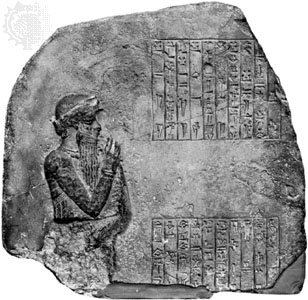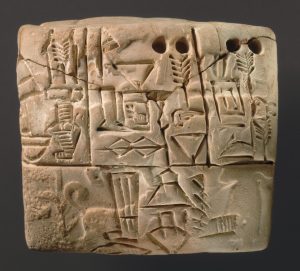Within the years 1792 and 1750 BCE, one of the most influential rulers known in ancient history emerged in the Babylonian Empire. Hammurabi took the throne as the sixth king of the first Babylonian Empire. He was known as a great warrior, an honored statesman, and an emperor who took a great interest in restoring the empire’s religious temples and values.1 He referred to himself as the “king of the four quarters of the world,” claiming that he was chosen by the gods to “destroy the wicked in the land and evil [so] that the strong might not oppress the weak.” Not only is Hammurabi known as a warrior, statesman, and religious man, but he is also remembered for his famous Code of Laws, the Hammurabi Code: a set of laws that is described as the “most extensive and most complete law code” of the Mesopotamian time.2

The laws were written on clay tablets to bring forth a legal system for those in authority to enforce. The Code acted as the legal foundation to a sophisticated society that the Babylonians had become. The laws were meant to bring a form of equality among the people. However, consequences and punishments given to a guilty party did not always reflect the kind of equality that we today would expect. These sets of laws not only brought a legal system, but also put on display the legal basis for a differentiated treatment of individuals based on wealth and gender. Within the Babylonian empire the population was divided into three classes.3 The classes were given the names Amelu, Muskenu, and Ardu. Each social class had specific rights and characteristics to them, as well as determined what quarter of the empire they were to live in.4
The code relies on the concept of lex talionis, or law of retaliation. It is commonly known as an “eye for an eye” justice. According to what the guilty party did, their punishment should thus reflect it.5 However, in some instances, this was not the case. The differences in punishments relied a great deal on which social class the victim or perpetrator belonged to. Many times, the Amelu, the elite class on the social spectrum, would be given lesser sentences than the poor by Hammurabi’s Code. For example, if the Amelu were to harm someone from the Muskenu class, the Amelu would merely be subject to a restitution in the form of silver. Committing the same crime against the Amelu, the Muskenu would be subjected to a much more severe punishment, in accordance with the Code. Furthermore, if the violator of the code could not pay or replace what had been harmed, the violator would be sent to immediate death.6 More often than not, it was the members of the lower class who were being accused of crimes and were unable to pay the restitutions.
The legal foundations of aristocratic privileges are evident in ancient Mesopotamian history. This was due to the economic importance and responsibilities held by the Amelu. During this time in history, one’s wealth, what official position one held, and which family one was born into, determined how one would be treated under the law. Differences in cases and punishment were arranged to benefit the “value” and “dignity” that the Amelu held within the society. The top of the social pyramid was seen as more important; therefore, committing any devaluing crime against them in any way was dealt with very firmly in comparison to how crimes committed on the Muskenu were handled.7 Although many judges of this civilization carried out the law according to Hammurabi’s standards, in which the higher class held a greater value in the society in comparison to the poor, some judges struggled to ensure that the Muskenu was not being oppressed by the Amelu.8
The code that Hammurabi introduced to the Babylonian people had a great impact as it brought social order and a structured legal system. Overall, the code created a commonality in standards for those in authority when deciding punishments and consequences to a violator of the law. Hammurabi’s Code is believed to be the first set of written laws in human history.
- George S. Duncan, “The Code of Moses and the Code of Hammurabi,” The Biblical World 23, no. 3 (1904): 188. ↵
- Jerry Bentley and Herbert Ziegler, Traditions & Encounters, Volume 1 From the Beginning to 1500, 5 edition (New York: McGraw-Hill Education, 2010), 29-30. ↵
- Salem Press Encyclopedia, August 2016, s.v. “Promulgation of Hammurabi’s Code,” by Mary Jegen. ↵
- Ancient History Sourcebook, 1915, “The Code of Hammurabi: Introduction,” by Charles Horne. ↵
- Jerry Bentley and Herbert Ziegler, Traditions & Encounters, Volume 1 From the Beginning to 1500, 5 edition, 30. ↵
- William F. Edgerton, “Amêlu and Muškênu in the Code of Hammurabi,” The American Journal of Semitic Languages and Literatures 41, no. 1 (1924): 58–63. ↵
- Edgerton, “Amêlu and Muškênu in the Code of Hammurabi,” 63. ↵
- Jerry Bentley and Herbert Ziegler, Traditions & Encounters, Volume 1 From the Beginning to 1500, 5 edition, 30. ↵



35 comments
Jakob Trevino
The fact that these codes were brought forth to create a legal system in this society is very interesting. The complex set of rules called for justice… but not for all. The poor class was treated as if they were nothing, nor owned nothing when their life was as precious as to those who were rich. The unequal laws and the eye for an eye system I believe doesn’t work and it breaks a lot of moral codes.
Juan Arceo
Hammurabi’s Code will undoubtedly go down as the basis/original set of laws in this world. It was interesting how literal they took the meaning of “an eye for an eye” as if you were convicted of a wrong act, the punishments that were ensued were insane. These laws were important as they brought upon the basis of laws that were eventually modified to go with our way of life.
Michael Hinojosa
I’ve only ever heard what Hammurabi’s Code was rather than the history behind it and the impact it had on todays society with the creation of many of our modern rules and laws that we follow unless we want to be punished for it. I think it’s important that all of us realize how truly important this set of laws was, and that we maybe even push to teach people about it more as it is an important pillar of foundation for our society.
Diego Terrazas
The Hammurabi code is an extensive law list that was probably much more intricate due to different social classes receiving different punishments. It is interesting to see how old the saying “an eye for an eye” is, and it is more surprising how I had its meaning completely warped. Nevertheless, it was just a tad unfair that the poor were being executed for not being able to pay for their crimes.
Samire Adam
It is important to note the importance of the Code of Hammurabi in history as the foundation of law codes in societies. This article gives great insight into how the values of social class were handled by the Babylonians and I believe that some of those qualities can be seen in present day society sometimes. It’s easy to read about of the Code of Hammurabi and be astonished by the fact that the wealthy Amelu were given punishments that were lower in severity than the less wealthy Muskenu, but it’s also important to note that our world can often times mirror this.
Arieana Martinez
I had never heard of Hammurabi’s Code or the history behind it. This article was a true revelation of the start of the corrupt justice systems that have been around (literally) as long as laws have been around. The class systems and their ways of sneaking around rules never cease to end, and it is cringeworthy to see people manipulating codes such as Hammurabi’s Code which are meant to be equal to all, and make it oppressive once again.
Raymond Nash Munoz III
Once finishing the entire article, all I could think was, “has much really changed in the inequality of the legal system? ” Like all things, The Hammurabi Code had good intentions to bring order, but what about greed, I doubt the code did anything to limit the influence of money in the legal system. The reason I doubt that any limitations on the influence of money were acknowledged in Hammurabi’s code is because our laws and ideas of order are highly based off Hammurabi’s code and we still allow money to control parts of the legal system. Now, I do understand that maybe somewhere in the comprehension of Hammurabi’s code we might have added or excluded things that tainted the code, but nonetheless we still see inequality in the legal system like that of the circumstances before the code was established.
Victoria Rodriguez
The code is not new information to me. I am familiar with it and the “eye for an eye” perspective. What I always wonder is how humans decided to create laws that target a group and that are very strict? Especially considering that it is the first known written law. Why was the retaliation perspective more important to them than a law that is more forgiving or fair?
Constancia Tijerina
I have heard of the Hammurabi Code before, but I never really understood the meaning behind it. Although this law is focused more on the equality of people and how they should be treated as equals, there was still this discrimination and bias around what exactly meant for “equality”. I love how this article raises the attention on what was exactly meant on equality within this society. Again, within this time period, there was really no such thing as equality. I enjoyed reading this article, very informative!
Elias Garza
The Hammurabi Code is an interesting way of running a community. These laws were used to enforce equality within each other, in both negative and positive ways. I use to believe in an “eye for an eye”, but sometimes I also believe in just turning the other cheek. It all depends on what kind of situation I am experiencing.